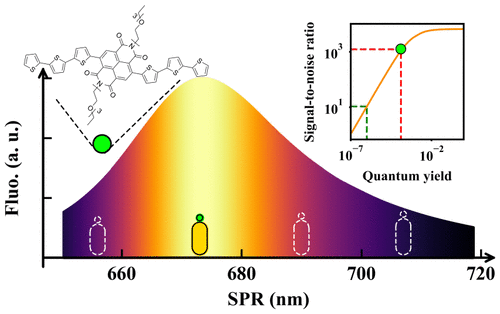当前位置:
X-MOL 学术
›
ACS Photonics
›
论文详情
Our official English website, www.x-mol.net, welcomes your feedback! (Note: you will need to create a separate account there.)
Quantum Yield Limits for the Detection of Single-Molecule Fluorescence Enhancement by a Gold Nanorod
ACS Photonics ( IF 7 ) Pub Date : 2020-08-13 , DOI: 10.1021/acsphotonics.0c00803 Xuxing Lu 1 , Gang Ye 2 , Deep Punj 1 , Ryan C. Chiechi 2 , Michel Orrit 1
ACS Photonics ( IF 7 ) Pub Date : 2020-08-13 , DOI: 10.1021/acsphotonics.0c00803 Xuxing Lu 1 , Gang Ye 2 , Deep Punj 1 , Ryan C. Chiechi 2 , Michel Orrit 1
Affiliation

|
Fluorescence-based single-molecule optical detection techniques are widely chosen over other methods, owing to the ease of background screening and better signal-to-noise throughput. Nonetheless, the methodology still suffers from limitations imposed by weak emitting properties of most molecules. Plasmonic nanostructures, such as gold nanorods, can significantly enhance the fluorescence signal of a weak emitter, extending the application of these techniques to a wider range of species. In this work, we explore the lower limit of fluorescence quantum yield for single-molecule detection, using a single gold nanorod to enhance molecular fluorescence. We specifically designed an infrared dye with the extremely low quantum yield of 10–4 and a comparatively large Stokes shift of 3000 cm–1 to demonstrate single-molecule detection by fluorescence enhancement. This example allows us to discuss more general cases. We estimate theoretically the optimal excitation wavelength and the plasmon resonance of the rod that maximize the fluorescence signals. We then confirm experimentally the detection of single-molecule fluorescence with an enhancement factor of 3 orders of magnitude for the quantum yield 10–4. Theoretical simulations indicate that single-molecule signals should be detectable for molecules with quantum yield as low as 10–6, provided the dwell time of the molecules in the plasmonic hot spot is long enough.
中文翻译:

金纳米棒检测单分子荧光增强的量子产率极限
基于荧光的单分子光学检测技术因其背景筛选的简便性和更好的信噪比而被广泛选择,而不是其他方法。然而,该方法仍然受到大多数分子的弱发射特性所施加的限制。等离子纳米结构,例如金纳米棒,可以显着增强弱发射体的荧光信号,从而将这些技术的应用扩展到更广泛的物种中。在这项工作中,我们探索了使用单个金纳米棒增强分子荧光的单分子检测荧光量子产率的下限。我们专门设计了一种红外染料,其量子产率极低,为10 –4,斯托克斯位移较大,为3000 cm –1通过荧光增强来证明单分子检测。这个例子使我们可以讨论更一般的情况。我们从理论上估计最大化荧光信号的杆的最佳激发波长和等离子体共振。然后,我们通过实验确认了量子产率为10 –4的单分子荧光的增强因子为3个数量级的检测。理论模拟表明,只要在等离激元热点中分子的停留时间足够长,对于量子产率低至10 –6的分子,应该可以检测到单分子信号。
更新日期:2020-09-16
中文翻译:

金纳米棒检测单分子荧光增强的量子产率极限
基于荧光的单分子光学检测技术因其背景筛选的简便性和更好的信噪比而被广泛选择,而不是其他方法。然而,该方法仍然受到大多数分子的弱发射特性所施加的限制。等离子纳米结构,例如金纳米棒,可以显着增强弱发射体的荧光信号,从而将这些技术的应用扩展到更广泛的物种中。在这项工作中,我们探索了使用单个金纳米棒增强分子荧光的单分子检测荧光量子产率的下限。我们专门设计了一种红外染料,其量子产率极低,为10 –4,斯托克斯位移较大,为3000 cm –1通过荧光增强来证明单分子检测。这个例子使我们可以讨论更一般的情况。我们从理论上估计最大化荧光信号的杆的最佳激发波长和等离子体共振。然后,我们通过实验确认了量子产率为10 –4的单分子荧光的增强因子为3个数量级的检测。理论模拟表明,只要在等离激元热点中分子的停留时间足够长,对于量子产率低至10 –6的分子,应该可以检测到单分子信号。



























 京公网安备 11010802027423号
京公网安备 11010802027423号